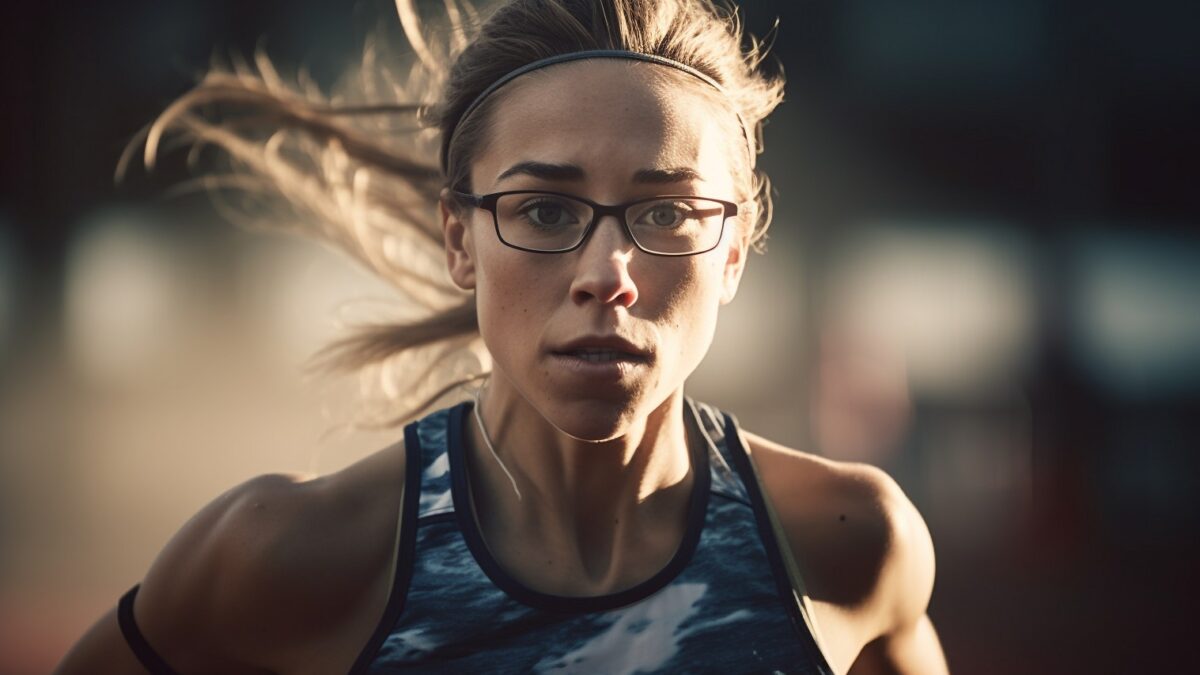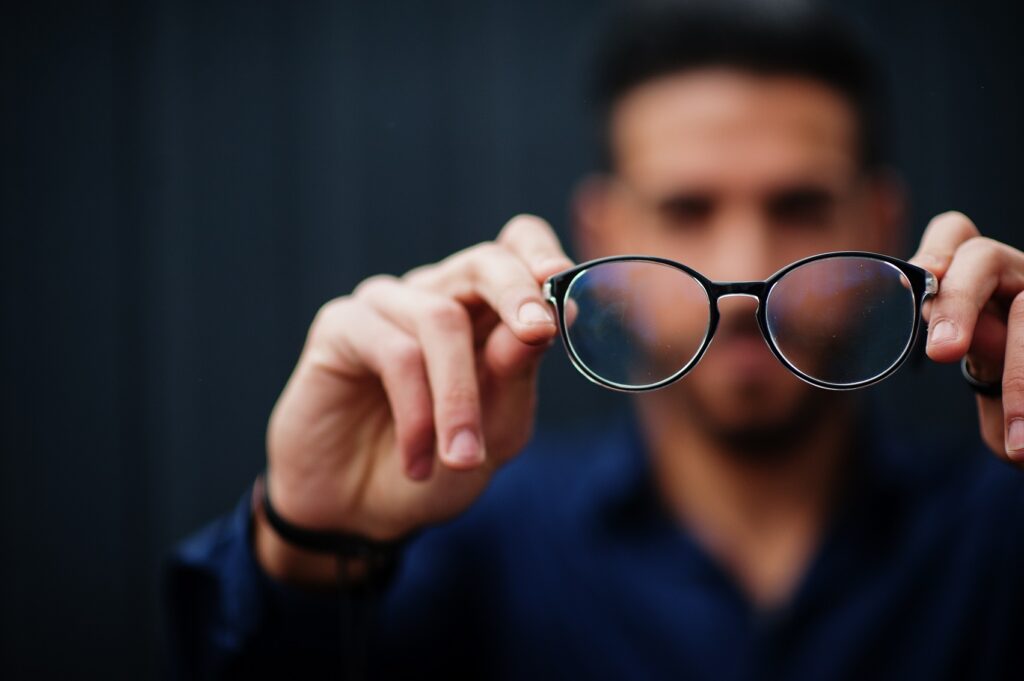Running with glasses: advantages, disadvantages and practical solutions!

Approximately 75% of the world’s adult population uses some form of available vision correction, of which nearly 64% of them choose to wear glasses. Among these people, of course, there are athletes from various fields, including runners. Running with glasses may involve some challenges and problems, but with some tips you can definitely increase the comfort of such activity.
It is also worth noting that running with glasses applies not only to people with visual impairments. Glasses can be one of the running accessories that will improve the comfort of our training, especially on sunny days. According to publicly available data, as many as approximately 85% of the entire population uses sunglasses, including people who exercise.
Can you run with glasses?
The answer to this question is simple: of course it is. When it comes to corrective glasses, if you belong to the group of people with vision impairment (in this case, especially myopia), it is definitely safer to run with glasses than without them. First of all, for your own safety and to ensure the comfort of running. Thanks to this, you will be able to minimize the risk of tripping or even a headache caused by blurred vision.
The second issue is sunglasses. In their case, their main role is protection against ultraviolet radiation, but it is also worth mentioning that by using them, you squint less often on sunny days and minimize the risk of something getting into your eyes.

However, as with any running equipment or accessory, deciding on the right glasses for your training may require special attention or additional planning.
Why is it worth running with glasses?
Although it may seem that running with glasses will not be very comfortable, it brings many benefits, especially if you have vision impairment:
- Visibility and avoiding running obstacles– using glasses while running not only helps you see better, and further and see more details but also reduces the risk of injury. You don’t have to worry about spraining your ankle or tripping because you didn’t notice a curb, a protruding root or a small hole in the sidewalk. Poor eyesight greatly increases the likelihood of injury by missing an obstacle;
- Convenience and ensuring comfort while running– if you wear glasses most of the day, it will be much better and more convenient to have them with you during training than to force yourself to use contact lenses that you are not used to. Many runners complain that when training with lenses, their eyes dry out and unwanted irritation occurs. Additionally, in some situations they may fall out – by choosing glasses, you will completely avoid this problem. Contact lenses can reduce the amount of oxygen reaching the eye, but glasses allow full air circulation;
- Protection against foreign bodies– wearing glasses, your eyes are much better protected against wind, dust particles and other pollutants. Additionally, the glasses also provide protection against branches and small insects, which may be difficult to remove during training. People who run without glasses may envy such protection;
- Visual acuity– glasses while running can also help improve concentration. By correcting your vision, they can help reduce eye strain, allowing you to focus on your run for longer periods of time;
- Protection against UV rays– C. Backes and co-authors in the study Eye exposure to sunlight: Predicted UV protection effectiveness of different sunglasses published in 2018 found that running wearing glasses with photochromic or dark lenses can reduce the risk of cataracts and corneal sunburn and other forms of irreversible eye damage from UV radiation.
Disadvantages of running with glasses
Of course, running with glasses has its disadvantages, which sometimes have a significant impact on the comfort of running. However, it is always worth thinking about the positives! This paragraph may help other runners understand the problems that people who run with glasses face:
- Running discomfort– runners wearing glasses indicate “jumping” up and down and the moving of the glasses during the run as one of the main challenges and obstacles. In some situations, they may even fall to the ground. This applies especially to situations when the glasses do not fit well and we wear everyday glasses, not intended for sports purposes;
- Drops of sweat- in the case of better-fitting glasses, drops of sweat may get onto them, which will impair our visibility and force us to constantly wipe the glasses – often with a sweaty T-shirt;
- Evaporation- When we sweat or run in high humidity, our glasses can fog up, which directly affects visibility and can be frustrating. Especially since wiping fogged glasses will have to be repeated, and the action itself may only further smudge the lenses;
- Light reflections– this especially applies to training after dark. When running at night, bright light may be reflected in the glasses, which will cause dangerous anomalies. Street lights, car headlights, or even using a headlamp can make it much more difficult to see clearly. When this effect is combined with, for example, glasses fogging, the risk of falling and injury increases significantly;
- Running in the rain– this is probably the biggest nightmare for people who train wearing glasses, which unfortunately do not have wipers like car windows. The drops that settle on your glasses significantly impair your vision, and the added moisture often causes them to fog up or even slide off your nose. When running in the rain, it is worth implementing a few important tips that will help you effectively combat this emerging problem: wear a baseball cap or just a visor (this will not eliminate fogging, but raindrops will not appear on the glasses), spray or wipe lenses with anti-fog or waterproof products, wear a microfiber cloth to clean your glasses (definitely a better solution than a sweaty T-shirt or wet hands), if rain is forecast, choose contact lenses.

How to run with glasses?
Choosing the right running glasses, whether prescription or sunglasses, can be a challenge. However, considering how important they are to many of us, it is worth spending some time and energy to find the perfect pair for your needs. Investing in appropriate glasses will help eliminate some of the disadvantages that running with glasses generally brings and, most importantly, improve the safety and comfort of training.
To increase the comfort of running with glasses, it is worth paying attention to several important aspects:
- Consider buying sports glasses that you will use during training. Running can destroy the pair that you use during the day (sweat, fall, etc.). Additionally, glasses for everyday use are not that comfortable for training. Sports have a specification to match;
- Keep your running glasses clean including hinges, nose pads, and temples, to minimize damage from dirt and sweat;
- Put on the headband, which will absorb sweat. This will prevent it from flowing onto the lenses;
- Look for an anti-fog spray that you can apply directly to your lenses;
- If you have trouble keeping your glasses in place, then use a sports belt adjustable for glasses. You can also hold your glasses with a bandana or headband in summer, and with a sports hat in winter;
- On rainy days wearing a baseball cap or just a visor will prevent raindrops from settling on the lenses;
- Carry a microfiber cloth in your pocket– you will be able to wipe your glasses safely. Using a sweaty T-shirt or hand may be pointless;
- If you train with glasses, race in them too.
What is worth paying attention to when choosing running glasses:
- Choose frames made of ultra-light and durable material;
- Try to choose a model with a rounded frame, this will provide a larger field of vision and increase the level of protection;
- Try on a large number of models and choose the best-fitting ones;
- Look for models with rubber ear grips and non-slip (maybe silicone) nose pads;
- Pay attention not only to the construction of the frames but also the lenses, make sure they are made of light and durable materials;
- Choose lenses with UV protection. Glasses with photochromic or dark lenses can reduce the risk of cataracts and corneal sunburn and other forms of irreversible eye damage from UV radiation;
- If it is not necessary, do not choose bifocal glasses. They may distort surfaces when you look down. If you want such a model, choose bifocal glasses deliberately set lower than traditional models.
Understand the other runner and don’t cross your glasses
Running with glasses doesn’t have to be burdensome and frustrating. While training with glasses, you can easily enjoy a comfortable and safe run, provided you choose properly fitting glasses. You should remember to take care of them, protect them and, of course, take your time to get used to running with glasses (there is no need to get discouraged right away).
Don’t let glasses stop you from achieving your dream running goals. Take up the challenge and boldly set out to conquer the running routes. On the Internet, you can find examples of people who raced at world-class events wearing prescription glasses. These include, among others: Sydney Wooderson (twice won the European Championships: 1,500 m in 1938 and 5,000 m in 1946. As a 19-year-old, he also won a silver medal at the 1934 Empire Games) and Tommy Awad (3rd place in the mile at the NCAA Indoor Championships in 2016, ran both the 1,500 m and 5,000 m at regionals and the NCAA East Championships).
